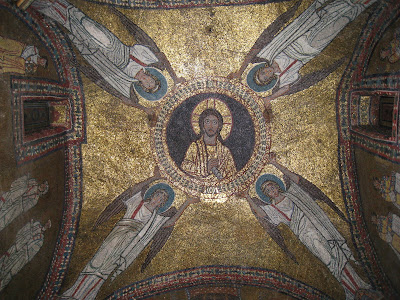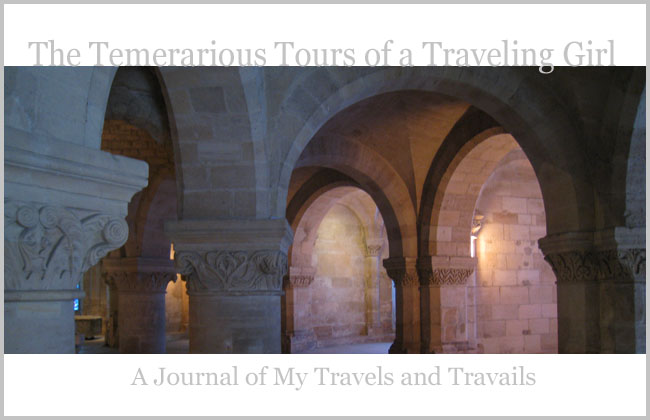
Trajan's Column

Trajan's Forum






Santa Costanza
From there, I went to San Pietro in Vincoli (St. Peter in Chains) which holds the relic of the chains used to bind St. Peter at the Mamertime Prison and which supposedly miraculously fused together when he was set free by an angel. The church also holds the tomb of Pope Julius II, much reduced from the original plan.
Tomb of Julius II in San Pietro in Vincoli
Next I saw Santa Prassede, a 9th century church with beautiful Byzantine mosaics in the apse over the altar and in the small chapel of San Zenone, and which supposedly has a piece of the column on which Christ was whipped before the Crucifixion.


Next up was the church of Quattro Coronati, an incredibly peaceful place in the heart of Rome. Frescoes in various states of disrepair decorated the wall to the right of the entrance, and there I found a partial depiction of the Crucifixion with a dead Christ graphically covered in blood, but eyes peacefully closed. There was no information about the images, so I’m going to have to find out more about the church and the frescoes, but this could be something interesting for my thesis.

 At San Clemente on the Celian Hill, in the Castiglione chapel I found a fresco depicting the Crucifixion by Masolino from around 1400 which could also be useful for my thesis, though again I don’t know the history of the church, and since the fresco is in a chapel, that limits the audience. I passed by the pyramid built by Gaius Cestius as his tomb in the 12th century B.C., just outside St. Paul’s gate on the south side of the city on my way to St. Paul’s Outside the Walls (San Paulo fuori le Mura), Rome’s fourth great basilica, along with St. Peter’s, S. Maria Maggiore, and the Lateran.
At San Clemente on the Celian Hill, in the Castiglione chapel I found a fresco depicting the Crucifixion by Masolino from around 1400 which could also be useful for my thesis, though again I don’t know the history of the church, and since the fresco is in a chapel, that limits the audience. I passed by the pyramid built by Gaius Cestius as his tomb in the 12th century B.C., just outside St. Paul’s gate on the south side of the city on my way to St. Paul’s Outside the Walls (San Paulo fuori le Mura), Rome’s fourth great basilica, along with St. Peter’s, S. Maria Maggiore, and the Lateran. The Basilica is huge, but unfortunately the building which we see now is not the fourth century original nor the 11th century restoration, but a 19th century construction following a catastrophic fire. Nonetheless, the building is impressive and the mosaics inside are beautiful.
The Basilica is huge, but unfortunately the building which we see now is not the fourth century original nor the 11th century restoration, but a 19th century construction following a catastrophic fire. Nonetheless, the building is impressive and the mosaics inside are beautiful.

 Finally, to end this very long day, I stopped at the base of the Aventine Hill to see the Temple of Hercules Victor and the so-called Mouth of Truth at Santa Maria in Cosmedin.
Finally, to end this very long day, I stopped at the base of the Aventine Hill to see the Temple of Hercules Victor and the so-called Mouth of Truth at Santa Maria in Cosmedin. The Mouth of Truth at Santa Maria in Cosmedin
The Mouth of Truth at Santa Maria in Cosmedin Temple of Hercules Victor
Temple of Hercules Victor
















1 comment:
Enjoyed the photos... what a lot to see in just a single day! You must have been exhausted!
I have been looking up the "Temple of Hercules Victor" today as I found it to be misidentified on the Getty Museum's website as the "Temple of Vesta" (a very common error I might add):
http://www.getty.edu/art/gettyguide/artObjectDetails?artobj=245805
Now I have to go look up what "temerarious" means... thanks for the images - and my new word for the day!
Mark Donaghey
Chicago
Post a Comment